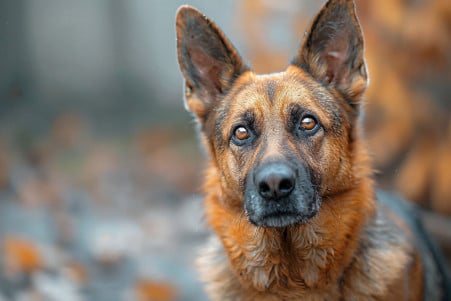What Are Puppy Fear Periods? A Parent's Guide to Developmental Phases
19 April 2024 • Updated 18 April 2024

If you've ever had a puppy, you know that they can be a little skittish at times. This is especially true during what's known as a puppy fear period. Puppy fear periods are completely normal phases in which puppies can suddenly become afraid of anything new in their environment. They tend to occur when a puppy is 8-10 weeks old and between 6-14 months old. Although they are temporary, it's important to carefully introduce your puppy to new things and situations during these times to help them feel more secure.
This article reviews the latest scientific research from animal behaviorists and veterinarians to help you better understand these developmental phases. By learning about the causes of puppy fear periods and how to deal with them, you can help your dog work through their fears and become a well-adjusted adult. This will help them develop the skills they need to manage new situations as they arise.
What are puppy fear periods?
How to Help Puppies Through Fear Periods
While puppy fear periods can be stressful for both puppies and their owners, it’s important to remember that you should never force your puppy to interact with something that they find scary. In the words of Pupford, "Don't force your puppy to engage with things that scare them. Allow your puppy to move away from whatever is scaring them." Instead, let your puppy take the lead in exploring new things and reward calm and confident behavior with treats and praise.
Make sure that you keep training sessions short and sweet and focus on positive reinforcement. According to Canidae, you should also make sure that you don’t stress your puppy out during fear periods. "Make sure you give your puppy enough stimulation, but also be sure to minimize stressful situations." It’s also important for you to stay calm, as your puppy will pick up on your energy. Gradually introduce your puppy to new things using gentle exposure and counterconditioning techniques.
While socialization is still important, it’s important to make sure that your puppy’s interactions are well-supervised and end on a positive note. As Pupford explains, "Make socialization a fun experience. Puppy socialization is the introduction of your puppy to new people, places, and things. Using positive reinforcement during socialization will make it a fun experience rather than add to the stress your puppy may already be experiencing." With time and patience, you can help your puppy build their confidence during these short-lived developmental periods.
Why Early Socialization Is Important
Proper socialization and exposure to puppies during their first few months of life is critical to preventing behavioral issues. The socialization period in puppies starts at 3 weeks of age and goes up to 12-14 weeks of age, depending on the breed, according to the Indoor Pet Initiative. During this time, the puppy's brain is developing social skills and making associations. Puppies that aren't properly socialized during this period can experience behavioral issues that last a lifetime.
The Michelson Found Animals Foundation notes that early socialization helps ensure the puppy's social development is healthy, preventing social avoidance and aggression due to fear of other dogs, people, or new places. The consequences of poor puppy socialization can be severe, leading to fear-based aggression, separation anxiety, and extreme timidity around people and other animals.
According to PetMD, dogs that haven't been socialized to new experiences will be fearful of anything that isn't familiar. This can lead to them having a fear of the unknown, which results in them being unwilling to approach new situations and places. Proper socialization during the critical 3-14 week period is important for ensuring that puppies grow into well-adjusted, confident adult dogs.
How to Tell If Your Puppy Is Scared
Knowing what to look for in terms of your puppy's body language can help you better understand when they are going through a fear period. According to The Wildest, signs of fear in puppies can be subtle and may include yawning, panting, lip-licking, and avoidance. More obvious signs of fear may include cowering, trembling, growling, and trying to escape.
According to The Spruce Pets, other signs of fear in puppies include ears that are flattened against the head, a tail that is tucked between the legs, a tail that is wagging stiffly, and pupils that are dilated. Kalmpets adds that puppies may also show signs of fear by hesitating to approach things they are familiar with, freezing when approached, or appearing to forget things they have learned.
It is important to recognize these signs of fear because, according to Oakland Animal Services, punishing or forcing a puppy to interact with something that they are afraid of can actually make their fear worse. By learning to recognize the signs of fear in their puppies, pet parents can offer the patient, supportive guidance that their puppies need to get through these normal, but sometimes challenging, periods of development.
Breed Differences and Individual Variation
Puppy fear periods are a normal part of a dog’s development, but the age at which they occur and their severity can vary widely between breeds. According to Zigzag, the first fear period can occur as early as 5 weeks in German Shepherds, while the "hazard avoidance" period in Cavalier King Charles Spaniels tends to happen around 8 weeks. In general, larger breeds have a slower emotional development, which means their fear periods will happen later in life and last longer than those of smaller breeds with faster emotional development.
In addition to breed differences, a puppy’s individual temperament and experiences can affect how severe their fear periods are. According to Diggs, “some puppies may be naturally more fearful or scared than others” and may have fear periods that last for several months. As a result, it’s important for dog owners to know the typical timeline for fear periods in their puppy’s breed and to be ready to offer them personalized support that’s tailored to their unique needs.
In the end, while fear periods are a normal part of a puppy’s development, they will be experienced differently by every dog. As Spot explains, “all puppies require patience and should be treated as individuals during fear periods.” With the right care and attention, most puppies will be able to work through these phases and become well-adjusted, confident adult dogs.
How to Help Dogs Through Fear Periods
While many dogs will naturally move past their fears during and after fear periods, some dogs may continue to struggle with certain fears. According to Canidae, this means that owners should continue to use desensitization and positive reinforcement to help their dog work through any residual anxieties. Meanwhile, the K-9 University warns that owners should avoid using any training techniques that could make their dog more fearful, including e-collars and physical corrections.
If a dog's fears continue and become debilitating, Preventive Vet suggests that owners seek out a certified professional dog trainer or veterinary behaviorist. These professionals can help to create a plan that will address the root of the problem through counter-conditioning and other proven methods.
Owners should also make sure that they're managing any environmental factors that could be making their dog's fears worse or that could be reinforcing them. This means that, as Preventive Vet explains, "Pay attention to your dog's comfort level and proceed at a pace that works for them." With the right help and support, most dogs will be able to work through their fears and become well-adjusted, confident adult dogs.
Conclusion: How to Raise Confident, Well-Adjusted Dogs
Puppy fear periods are a normal part of development that signal temporary periods of increased sensitivity and anxiety in response to new stimuli. Fear periods typically occur between 8-11 weeks and 6-14 months of age, but the exact timing and duration of these periods can vary by breed.
During fear periods, puppies may show signs of fear, including hesitancy, avoidance, and being easily startled. Although these signs can be distressing for owners, they are a normal part of the process of helping puppies learn what to be cautious of and develop survival instincts. With patience and the right handling, owners can help their puppies navigate these temporary periods.
The most important thing to remember is not to force puppies to face things that scare them. Instead, let them explore new things at their own pace and reward them for being calm and brave. Keep training sessions short and positive, and make sure you remain calm so that you don't inadvertently make your puppy more anxious. Pupford suggests that you make socialization a "fun experience" by using positive reinforcement.
Positive socialization is also important for preventing long-term behavioral issues. Puppies who don't get properly socialized during the critical 3-14 week period can become fearful, anxious, and even aggressive as adults. Michelson Found Animals notes that under-socialized dogs often have trouble with basic handling and new environments.
While most puppies will overcome fear periods with the right support, some may continue to have fears and anxieties. In these cases, it's important to continue to use a combination of gradual desensitization and positive reinforcement, and to seek professional help if the fears begin to have a negative impact on the puppy's life. With the right support, most puppies will overcome their fears and grow into confident, well-adjusted adult dogs.


